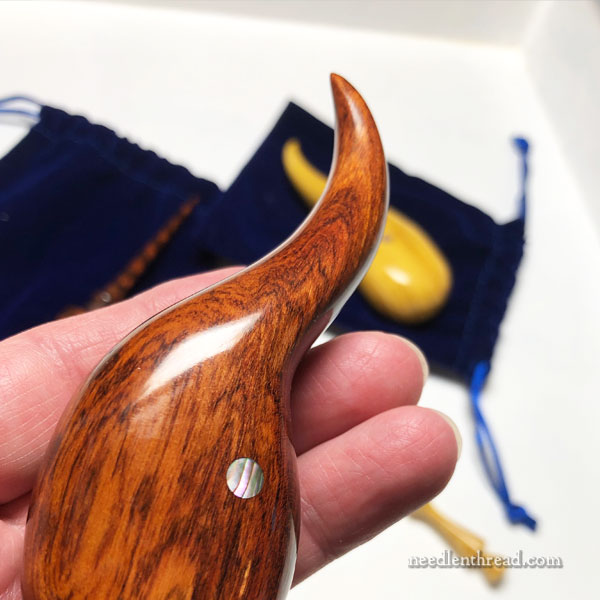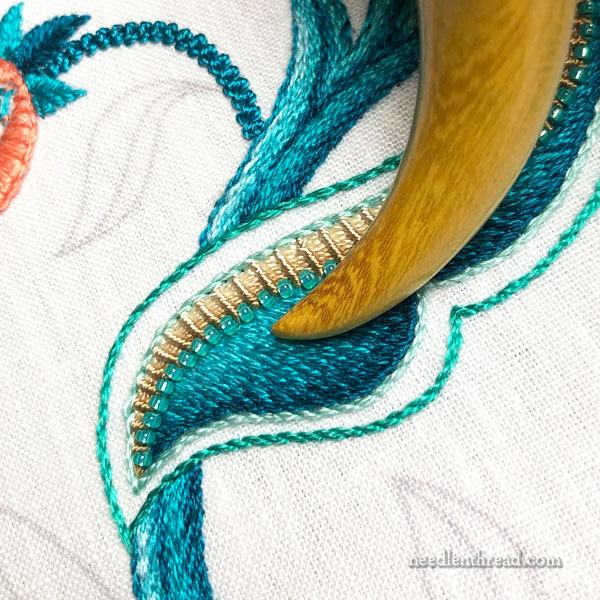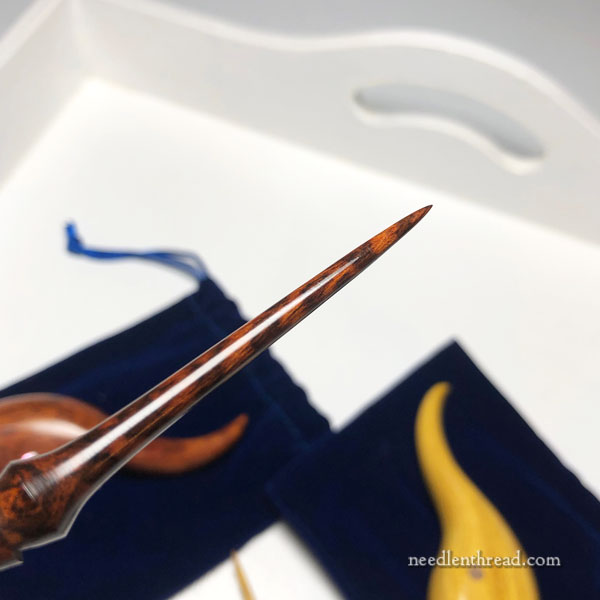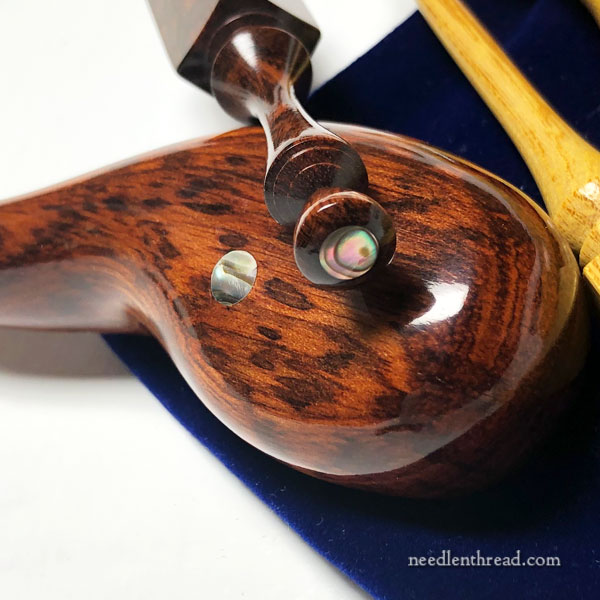Every hobby, craft, and artistic pursuit requires tools.
True, not all tools are essential to the craft.
If you take embroidery, for example, as things go, it requires very few tools. At the minimum, embroidery simply requires a needle. I suppose even scissors could be considered unnecessary – if you have good teeth!
But the fact is, good tools can make embroidery less frustrating and more efficient. And beautiful good tools can also add a certain aesthetic value to the embroiderer’s experience, enhancing the embroiderer’s pleasure while using them just by virtue of the fact that they are beautiful.
As you progress in your embroidery journey, it makes sense to add tools to your embroidery workbox that are not only useful, but also beautiful.
Today, I want to show you some beautiful and useful embroidery tools.

Several years ago, I wrote about the aficot.
This is a tool that is used perhaps more regularly in lace-making, but that is also used in embroidery for burnishing – or smoothing and polishing – certain stitches, especially satin stitches.
Modeled on the lobster claw, which was originally used for burnishing fabric channels in certain types of lace-making, the aficot is made from wood, of a particular shape to make it easy to hold in the hand, and polished to such a high degree that there is no chance of snagging or uprooting the fibers that it is used to burnish.

Aficots have become a little more prevalent on the market today. They were hard to come by when I originally wrote about them – I had to hunt my first one down – but now you can find different qualities of aficots available around the globe.
Personally, I like an aficot that has these qualities:
1. It should have a little weight to it. That is, it’s not made from a light and porous wood, but from a denser hardwood.
2. The ball of the aficot should fit nicely in the hand and be comfortable to hold.
3. The aficot should be smooth as glass, with no begad nonsense about it. You should be able to run your hands over it and never feel a mar, a fisher, a bubble or bristle, a splinter or rough patch. It must be, in short, a perfect surface for the job requirements.
4. And though it isn’t crucial to the work of the aficot, I like an aficot that is lovely to behold. I like good wood. I don’t know a lot about wood, but I love to see the nuances in a beautiful piece of wood. So, yes, I like aficots that are made from pretty wood!

The aficots I’m showing here fit all those requirements in a most thorough way. They are gorgeous.
Inset in each aficot is an abalone accent that adds a unique touch.

I’ve been using the aficots to burnish satin stitching on my Jacobean project.
It helps the satin stitches lie smoothly, and it does actually shine them up a bit! Normally, I use an aficot when I’m doing monograms or something similar, that involve a lot more satin stitch, but lately, I’ve taken to using them for smoothing and blending other stitches, too.

For example, after finishing an area filled with long and short stitch, burnishing the tops of the filled area with the aficot polishes the stitches and forces them to blend in a smooth, lovely way.
Another filling that I’ve used the aficot on successfully is split stitch filling with floche and with silk. It brings out a certain gleam in the filling.
I really love this tool! While it is far from being fundamentally necessary in embroidery, it definitely enhances certain stitches and techniques, and I think it’s worth having in the tool box, if you are a fully committed embroiderer.
Matching Laying Tools

These particular aficots have matching wooden laying tools, too, and the laying tools are no less beautiful. They are delicately turned, wondrously smooth, and conscientiously made to be functional and pretty.

The squared handle keeps them from rolling and gives the needleworker a nice place to hold the tool. The end of the laying tool has an abalone inset to match the inset on the aficot.

The two sets of tools I’m showing you here are made from snakewood (the darker set with a lovely, dark pattern in the grain) and from osage orange (the lighter set, with its linear, bright grain that glints with deep golden honey colors).
I never, ever would have known that the osage orange tree – which lines every road, lane, and walking path close by and hurls its massive brain fruit to the ground every autumn – sported such a stunning wood behind its bark!
Where to Find Them
These lovely tool sets are the result of the superior craftsmanship of Jeff Roberts, a wood turner in Georgia. He has an Etsy shop under Boxwoodruler – Jeff Roberts Wood Crafts.
The sets he offers are exquisite. They come packaged quite nicely, too, in a velveteen drawstring bag for the aficot and a protective tube for the laying tool.
Some of the woods he uses are really stunning – check out the Asian ironwood, for example. The burled wood is … wow! Sumptuous!
So, if you’re in the market for a laying tool, an aficot, or a matching set of both, check out Jeff’s shop! Add him to your list!
Have a fabulous Friday!







I’ve used an aficot for years when making needlelace but never thought to use it on embroidery. Thanks for the idea.
P.S. I live in the lobster capital of the world, so I use a lobster claw. There’s always 1 of the 2 claws that is smooth, so it just needs cleaning out and some time in bleach, and it’s great and lasts forever. It’s also a good excuse to buy a lobster!
P.P.S. For unilingual English speakers, aficot is a French word which is pronounced “afeecoe”.
“I never, ever would have known that the osage orange tree – which lines every road, lane, and walking path close by and hurls its massive brain fruit to the ground every autumn – sported such a stunning wood behind its bark!”
“Massive brain fruit” — hahaha! I remember when I first moved to northeast Kansas, I was idly looking out a bus window one day, and I thought, “What are all those…. things…. in the gutter, that look like tennis balls gone bad?”
Before the year was out, I was dating someone who heated his home with a woodstove, so I got very familiar with the color of the inside of that tree! (Also, if you ever need to know — it burns VERY hot, and puts out a lot of sparks.)
Several years later, still living out in the country, I had a little toddler who pronounced “hedge apples” as “dedge bapples.” I sometimes still think of them with that pronunciation. 🙂
Also, THE THORNS! I learned that those were the reason behind their use as “hedges.” Natural barbed wire!
Ah, memories!
Those are beautiful. And aficot is such a great word! I will have to remember that for Srabble…
Osage orange is a great wood. You can get a lovely yellow dye out of it!
These are pretty- I, too, enjoy tools that are beautiful in their own right. What is the function of a laying tool?
Hi, Marsha – You can read about laying tools here: https://needlenthread.wpengine.com/2011/10/whats-a-laying-tool.html
And you can see it in action here: https://needlenthread.wpengine.com/2010/11/how-to-use-a-laying-tool-video.html
Hi Mary! I love my Aficot and am glad that they’re available again! I got mine from the super people at NeedlePaws in the UK, but sadly they’re no longer in business. I use my Aficot while I’m sewing, as well as in my embroidery. It ‘finger’ presses seams open, pokes out corners and provides a nice curved area to shape fabric. It feels delightful in my hand and is one of my favorite tools.
Can I just comment that the type of lacemaking that the afficot is used for is needlelace which is after all a form of embroidery with variations on detached buttonhole stitch. The afficot is used to smooth and polish the buttonhole stitch edges.
It isn’t used for bobbin lace (which is weaving) and this is what many people think of when they hear lacemaking mentioned, or for tatting (a form of knotting), knitted lace or crochet lace.
oh my— those are so gorgeous!
Hi Mary! I bought a wool crewel work project about 40 years ago and never started. Since we’ve been on lock down, I dug it out and got started. I’m more than half-way finished. I’ve struggled a bit getting some of the stitches to lay the way I want them to – would a tool like this possible work on the wool? I love reading your blog posts!
Hi, Susan – You might do better with a laying tool, which will help you place the stitch while it’s in process. It keeps the thread from tangling or twisting, etc. The aficot is more for polishing and smoothing up certain stitches after the embroidery is finished. Although, yes, it would work for polishing up satin stitch in wool, too.
Dearest Mary,
I contacted Jeff Roberts Woods Crafts after buying the last olive wood from the Holy Land aficot and companion laying tool. He has more coming down the pike. I’m thrilled! My 85 year old mother and best friend nearly cried when I told her I got the last one. ☹️
Thank you,
Melanie
Thank you. That was fascinating. I am a lace maker and found out about burnishing lace with a lobster claw many years ago while visiting the lace museums in Alencon and have burnished both my lace and embroideries ever since. I use the very smooth handle of my best embroidery scissors! I shall be looking out for an aficot now!
I have two laying tools by the same maker, and I love them! I’ve never known what an aficot was for — so I never invested! Thanks for clearing up that mystery!
🙂 Now you need one! LOL!
Bois d’arc, hedge apple, osage orange… This tree had several names that are quite descriptive. It was used for making bows and fence-like borders. It’s one tough wood. It was often used as a corner post in fences — if you could drive a steeple (nail) into this hard, dense, long-lasting wood! Folklore says that the fruit will keep away ants if you stick the fruit under under your house. I have a lucet made out of it, and won’t have to worry about breaking it!
Can aficots be used to burnish and smooth any threads (silk, cotton,etc.). I had never heard of them and love this article.
Than you.
Elizabeth
Yes, I use them with silk all the time!
Mary – I can’t thank you enough for your directing me to Jeff Roberts Woodcrafts. I ordered and received a beautiful laying tool. It far exceeded my expectations. It truly is a work of art.
I recently purchased a set from Jeff, and he was absolutely wonderful about exchanging and replacing for me when I was dithering about my order. You can’t go wrong with him! (And the snakewood– definitely spring for the snakewood!)
I purchased one of these tools and am now a fan. I was using the eye end of my needle to comb my satin stitches prior to this tool. The aficot makes it so much easier to polish an area without fear of snagging stitches. The workmanship is absolutely beautiful.